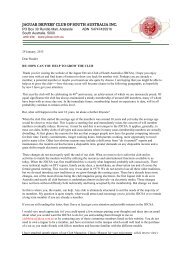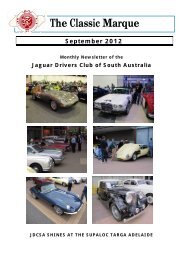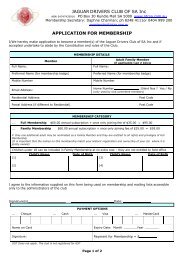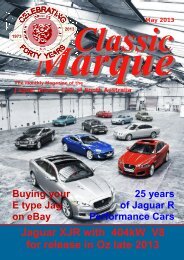Classic Marque Template April 2013 - Jaguar Drivers Club of South ...
Classic Marque Template April 2013 - Jaguar Drivers Club of South ...
Classic Marque Template April 2013 - Jaguar Drivers Club of South ...
- No tags were found...
Create successful ePaper yourself
Turn your PDF publications into a flip-book with our unique Google optimized e-Paper software.
- T E C H F I L E S -<strong>Club</strong> Torque‘S’-type BrakeLights - Aaaagh!I am not sure that I personally qualify to be writingthis months TECH FILE. But in the absence <strong>of</strong> anysubmission by others far more qualified I have writtenthis article that should be regarded more as aDIY <strong>Jaguar</strong> enthusiasts solution toa common problem in the hopethat it may be <strong>of</strong> help to someone.From the day I purchased my ’S’ -type in 2009 I had the ongoing issue<strong>of</strong> failing brake lights. Thelights are <strong>of</strong> course operated by thein-line pressure switch on the side<strong>of</strong> the engine block. This arrangementin itself, even when theswitch does work is somewhat inefficientin that the lights are ratherslow in coming on given that theyrely on brake pedal pressure. Tomake things worse if the pressureswitch fails as I found they continually did despiteconstant replacement, there is no way <strong>of</strong> knowingone is driving without brake lights.For me the solution was cheap, efficient anda DIY job, resulting in a reliable trouble free andsafe brake light system.I determined that by fitting an electric switch on thepedal, wired into the existing pressure switch loomwhich is left in place, so it is easily reversed, andinstalling a high LED brake light in the rear windowwith an indicator that can be seen in the rear viewmirror I would resolve all issues.So it was <strong>of</strong>f to Repco where I purchased a genericbrake pedal switch, in this case it was a Nissanswitch. The switch has to be what is called a“normally closed” switch. Meaning that as the switch‘S’-type1963—<strong>2013</strong>sits in your hand the points are closed or the circuitis closed permitting electric current. Why is this important?Because. the switch has to be mounted onthe drivers side, not the firewall side <strong>of</strong> the pedal. Ifound this very simple by manufacturing a metalbracket and fixing it in position under the dash sothat when the pedal is in its normal rest position,pressure is exerted on the switchholding the switch points open(breaking the circuit) preventing anycurrent and therefore not lighting thebrake light. Properly adjusted, theslightest pressure on the pedal, allowsthe switch to close immediatelylighting up the brake lights.Now one important point here is thatit is necessary to provide a flat spoton the brake pedal at the point itmakes contact with the switchplunger. I was able to grind a smallflat spot first but then fashioned ametal bracket with a broader flatsurface to fit over the pedal and fixed it in place withsome Selleys ‘Need-it’ ( a wonderful product)While at Repco I picked up a very neat LED brakelight strip for the rear window and wired it into thestandard loom behind the tail lights. The indicatorlight can be seen in the rear view mirror, so no morewondering, do I or don’t I have brake lights.This system has been in place faultlessly now forover twelve months. I suspect that the same simplemodification could be made to most early modelsthat rely on these rather untrustworthy pressureswitches.Philip Prior(If you have a simple tip or solution to a commonproblem, please send it in for publication)23










